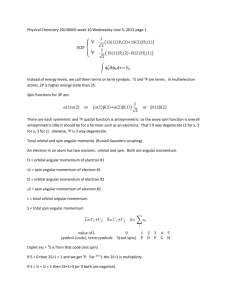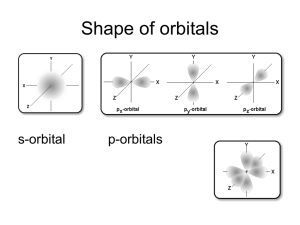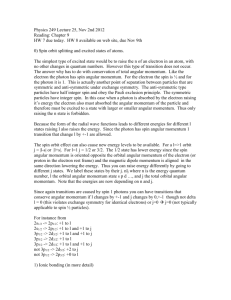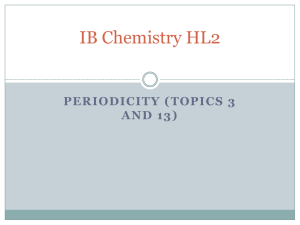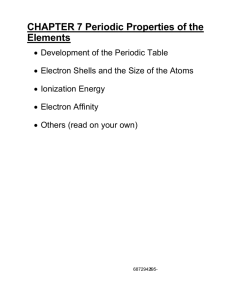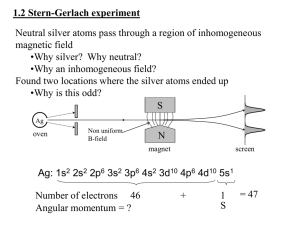Electron spin and the periodic table
advertisement
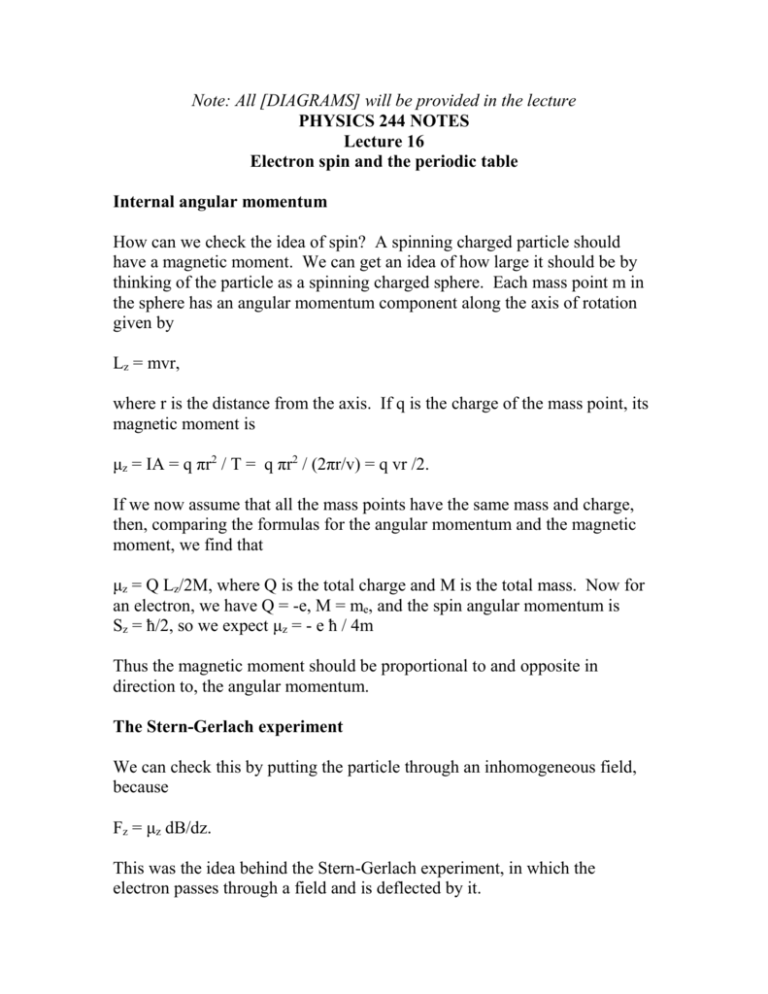
Note: All [DIAGRAMS] will be provided in the lecture PHYSICS 244 NOTES Lecture 16 Electron spin and the periodic table Internal angular momentum How can we check the idea of spin? A spinning charged particle should have a magnetic moment. We can get an idea of how large it should be by thinking of the particle as a spinning charged sphere. Each mass point m in the sphere has an angular momentum component along the axis of rotation given by Lz = mvr, where r is the distance from the axis. If q is the charge of the mass point, its magnetic moment is μz = IA = q πr2 / T = q πr2 / (2πr/v) = q vr /2. If we now assume that all the mass points have the same mass and charge, then, comparing the formulas for the angular momentum and the magnetic moment, we find that μz = Q Lz/2M, where Q is the total charge and M is the total mass. Now for an electron, we have Q = -e, M = me, and the spin angular momentum is Sz = ħ/2, so we expect μz = - e ħ / 4m Thus the magnetic moment should be proportional to and opposite in direction to, the angular momentum. The Stern-Gerlach experiment We can check this by putting the particle through an inhomogeneous field, because Fz = μz dB/dz. This was the idea behind the Stern-Gerlach experiment, in which the electron passes through a field and is deflected by it. [[DIAGRAM]] If this is done with electrons, then there are just two possible paths, corresponding to spin up and spin down. Angular momentum, including the internal angular momentum, is always quantized in quantum mechanics. (Actually, the original experiment used silver atoms, but their moment comes from the spin of an unpaired electron, so it is basically the same thing.) In the experiments, it is found that the actual moment is μz = - e ħ / 2 m, so it is just twice the expected value. This was called the anomalous moment. But the idea that the spin projection on an axis takes on just two precise values was verified. The periodic table Since the time of Mendeleev in the mid-19th century, it was known that if the elements are ordered by their masses, there are periodicities in their chemical properties. This is a remarkable observation and it was a complete mystery until 1926. We can now see that successively heavier elements are obtained by adding one positive charge to the nucleus and one electron to neutralize it. With the Pauli exclusion principle and the enumeration of the states using the quantum numbers n,l,m, and Sz, we can easily understand the periodic table. Let us write down the electronic configurations of the first few elements: H: 1s1 B: 1s22s22p1 F: 1s22s22p5 He: 1s2 C: 1s22s22p2 Ne: 1s22s22p6 Li: 1s22s1 N: 1s22s22p3 Na: 1s22s22p63s1 Be: 1s22s2 O: 1s22s22p4 We can see what is happening – the “shells” 1s,2s,2p,3s,3p,4s, 3d, 4p etc. fill up in turn. (Note the unexpected order of 4s and 3d – this comes about because the additional energy required to give l=2 overcomes the increase in n.) When there is a filled shell, the electron configuration is very stable, which accounts for the fact that the inert gases do not form chemical compounds easily at all. Elements with precisely one electron over a filled shell will be very easy to ionize by removing an electron. So Na+ is very common. Such elements are called electropositive. These elements are also very active chemically. Conversely, elements with precisely one electron less than a filled shell will be very easy to ionize by adding an electron. So F- is very common. Such elements are called electronegative. They are also very active chemically, but play a role complementary to the electropositive ones. Elements with roughly half-filled shells such as the transition metals will form compounds in numerous ways. The most versatile element of all is carbon with its 2 2p electrons and four slots for adding more electrons. Ionization energies Many other properties beside chemical behavior show periodicity. One of the most striking is the ionization energies. [[DIAGRAM]] The ionization energies for the alkali atoms are relatively small. An alkali atom is almost like a hydrogen atom in the sense that the outermost electron sees a well-defined almost impenetrable core that has a charge of +e. The successive alkalis (including H) are then in configurations 1s for H, core +2s for Li, core + 3s for Na core +4s for K, etc. Their ionization energies might be expected to form a decreasing series 13.6 eV, 13.6 eV/4, and they do, more or less. When the next electron is added, its ionization energy is bigger because it penetrates the cloud more and sees a bigger charge. So the ionization energies continue to increase until the shell is full, then the whole process starts again. This is not quite the whole story because there are subshell effects when, for example, the 2p subshell starts in C, the ionization energy is a bit less than that of B. This gives the little wiggles we see in the graph of ionization energies vs. Z. Atomic radii A similar story is seen in R, the atomic radius, vs. Z. The alkalis have the largest radii: the configurations 1s for H, core +2s for Li, core + 3s for Na core +4s for K, etc., are hydrogenic. But remember the radius increase with principal quantum number, so the overall trend is upward. As a shell fills, however, the effective charge seen by the last electron increases, so the radius of its orbit decreases. Hence there is a trend downward as a shell is filled. One really striking fact is that all atoms have roughly the same size 0.1nm to 2.5 nm (except for H and He, which are smaller). You might expect that the radius of an atom would be proportional to the number of electrons – this is not the case. The radii of Li (Z=3) and La(Z=57) differ by only about 25%!

